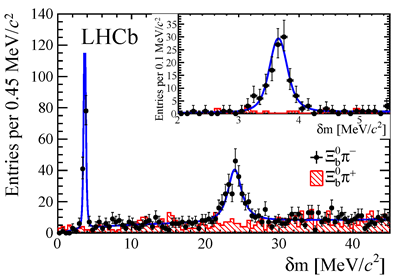The LHCb collaboration submitted today a paper reporting the discovery of two new particles. The particles, known as the Ξb‘- and Ξb*-, were predicted to exist by the quark model but had never been seen before.
Like the protons that the LHC accelerates, the new particles are baryons made from three quarks bound together by the strong force. The types of quarks are different, however: the new Ξb particles both contain one beauty (b), one strange (s), and one down (d) quark. Thanks to the heavyweight b quarks, they are more than six times as massive as the proton. But the particles are more than just the sum of their parts: their mass also depends on how they are configured. Each of the quarks has an attribute called “spin“. In the Ξb‘- state, the spins of the two lighter quarks point in the opposite direction to the b quark, whereas in the Ξb*- state they are aligned. This difference makes the Ξb*- a little heavier.
The two new particles are observed through their decay into the ground state Ξb0 and a π–. The image shows the distribution of δm, which is defined as the invariant mass of of the Ξb0π– pair minus the sum of the π– mass and the measured Ξb0 mass. This definition means that the lightest possible mass for the Ξb0π– pair, known as the threshold, is at δm=0. The two peaks are clear observation of the Ξb‘- (left) and Ξb*- (right) baryons above the hatched red histogram representing the expected background. Both particles have extremely short lifetimes and do not fly any measurable distance before they decay. But we can tell that the Ξb*- is the more unstable of the two, since the peak is wider and the basic rules of quantum mechanics relate the average lifetime of a particle to the width of its mass peak (after taking into account experimental resolution). This is consistent with the pattern of masses: the Ξb‘- mass is just slightly heavier than the threshold, so it is allowed to decay into a Ξb0 and a π– but only barely. The insert shows a zoom in the Ξb‘- δm region.
The masses, widths, production rates of these particles and more details on the analysis can be found in the LHCb publication. The result shows the extraordinary precision that LHCb is capable of: the mass difference between the Ξb‘- and the Ξb0 is measured with an uncertainty of 0.02 MeV/c2, less than four one-millionths of the total Ξb0 mass. By observing these particles and measuring their properties with such accuracy, LHCb physicists make a stringent test of models of nonperturbative Quantum Chromodynamics (QCD). Theorists will be able to use these measurements as an anchor-point for future predictions.
Read more in the CERN press release in English and French, in the Research Highlights of Nature, in the Scientic American and in the Physics World news.

